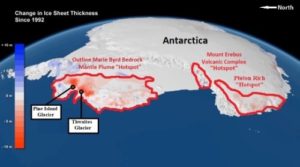by J.E. Kamis, July 20, 2020 in ClimateChangeDispatch
As previously explained before, increased melting/ice loss of Antarctica’s Pine Island and Thwaites glaciers is the result of geologically induced heat flow emitted from underlying bedrock “hotspots,” not climate change (Figure 1).
All but a very minor amount of Antarctica’s glacial ice melting occurs in the western portion of this continent. The most rapid and greatest ice mass loss areas are in West Antarctica.
They are positioned directly above geographically extensive and high heat flow geological features. This association is thought to be strong evidence of a cause and effect relationship.
Discussion of evidence supporting the contention that the melting of Pine Island and Thwaites glaciers is the result of bedrock heat flow begins with a review of the regional geology (refer to Figure 1).
The Pluton Rich “hotspot” is a 61,000-thousand-square-mile area that is home to numerous high-heat-flow lava pockets that are bounded and fueled by deep earth reaching faults.
Several detailed research studies document the existence and configuration of this area. This lies along the West Antarctic Rift.
The Mount Erebus Volcanic Complex “Hotspot” is the most geologically active portion of Antarctica. It is a 25,000-square-mile high-heat-flow area, much of which is absent of glacial ice.
The absence of glacial ice across a huge portion of West Antarctica is extremely unusual and exceedingly difficult to explain by invoking global warming.
…
Figure 1. NASA map of Antarctica’s ice sheet thickness 1992-2017. Greatest ice thickness losses shaded red. The outline of three regional sub-glacial geological Hotspots” are outlined in red (Image by NASA, most labeling by J. Kamis).
…

